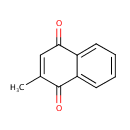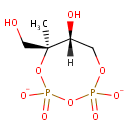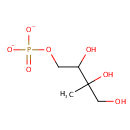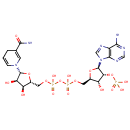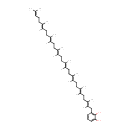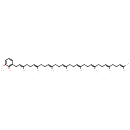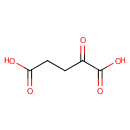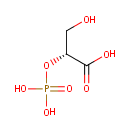
Search Results for compounds
Searching compounds for
returned 4373 results.
Menaquinone (PAMDB000610)
IUPAC:
2-methyl-1,4-dihydronaphthalene-1,4-dione
CAS: 58-27-5
Description: Menaquinone is a naphthoquinone without the isoprenoid side chain and biological activity. It is sometimes called vitamin K3, although derivatives of naphthoquinone without the sidechain in the 3-position cannot exert all the functions of the K vitamins.
2-C-Methyl-D-erythritol-2,4-cyclodiphosphate (PAMDB000611)
IUPAC:
(6S,7R)-7-hydroxy-6-(hydroxymethyl)-6-methyl-2,4-dioxo-1,3,5,2???4???trioxadiphosphocane-2,4-bis(olate)
CAS: 143488-44-2
Description: 2-c-methyl-D-erythritol-2,4-cyclodiphosphate is a member of the chemical class known as Organic Pyrophosphates. These are organic compounds containing the pyrophosphate oxoanion, with the structure OP([O-])(=O)OP(O)([O-])=O.
2-C-Methyl-D-erythritol-4-phosphate (PAMDB000612)
IUPAC:
2-methyl-4-(phosphonatooxy)butane-1,2,3-triol
CAS: Not Available
Description: 2-c-methyl-D-erythritol-4-phosphate is a member of the chemical class known as Tetroses. These are tetrasaccharides whose saccharide units are all hexoses. 2-C-methyl-D-erythritol-4-phosphate is involved in isoprenoid biosynthesis. Using genetically engineered Pseudomonas aeruginosa cells able to utilize exogenously provided mevalonate for isoprenoid biosynthesis by the mevalonate pathway we demonstrate that the lytB gene is involved in the trunk line of the MEP pathway. (PMID 11418107) The first step of the 2-C-methyl-D-erythritol 4-phosphate (MEP) pathway for isoprenoid biosynthesis in plant plastids and most eubacteria is catalyzed by 1-deoxy-D-xylulose 5-phosphate synthase (DXS), a recently described transketolase-like enzyme. (PMID 11708793) In the MEP pathway, 4-diphosphocytidyl-2-C-methyl-D-erythritol is formed from 2-C-methyl-D-erythritol 4-phosphate (MEP) and CTP in a reaction catalyzed by a 4-diphosphocytidyl-2-C-methyl-D-erythritol synthase (IspD). (PMID 17921290) (E)-4-Hydroxy-3-methylbut-2-enyl diphosphate synthase (GcpE), which catalyzes the conversion of 2-C-methyl-D-erythritol cyclodiphosphate (MEcPP) into (E)-4-hydroxy-3-methylbut-2-enyl diphosphate (HMBPP), is an essential enzyme of the non-mevalonate (2-C-methyl-D-erythritol-4-phosphate (MEP)) pathway for isoprenoid biosynthesis. (E)-4-Hydroxy-3-methylbut-2-enyl diphosphate synthase (GcpE), which catalyzes the conversion of 2-C-methyl-D-erythritol cyclodiphosphate (MEcPP) into (E)-4-hydroxy-3-methylbut-2-enyl diphosphate (HMBPP), is an essential enzyme of the non-mevalonate (2-C-methyl-D-erythritol-4-phosphate (MEP)) pathway for isoprenoid biosynthesis. (PMID 15792953) Pseudomonas aeruginosa AmtB is a member of the MEP/Amt family of ammonia transporters found in archaea, eubacteria, fungi, plants and animals. (PMID 12753193)
NADPH (PAMDB000615)
IUPAC:
{[(2R,3R,4R,5R)-2-(6-amino-9H-purin-9-yl)-5-[({[({[(2R,3S,4R,5R)-5-(3-carbamoyl-1,4-dihydropyridin-1-yl)-3,4-dihydroxyoxolan-2-yl]methoxy}(hydroxy)phosphoryl)oxy](hydroxy)phosphoryl}oxy)methyl]-4-hydroxyoxolan-3-yl]oxy}phosphonic acid
CAS: 53-57-6
Description: Nicotinamide adenine dinucleotide phosphate. A coenzyme composed of ribosylnicotinamide 5'-phosphate (NMN) coupled by pyrophosphate linkage to the 5'-phosphate adenosine 2',5'-bisphosphate. It serves as an electron carrier in a number of reactions, being alternately oxidized (NADP+) and reduced (NADPH). (Dorland, 27th ed.)
2-Octaprenyl-6-hydroxyphenol (PAMDB000619)
IUPAC:
3-[(2E,6E,10E,14E,18E,22E,26E)-3,7,11,15,19,23,27,31-octamethyldotriaconta-2,6,10,14,18,22,26,30-octaen-1-yl]benzene-1,2-diol
CAS: Not Available
Description: 2-octaprenyl-6-hydroxyphenol belongs to the class of Tetraterpenes. These are terpene molecules containing 10 consecutively linked isoprene units. (inferred from compound structure)2-octaprenyl-6-hydroxyphenol is invovled in Ubiquinone and other terpenoid-quinone biosynthesis, and Biosynthesis of secondary metabolites. (KEGG)
2-Octaprenyl-6-methoxyphenol (PAMDB000621)
IUPAC:
2-methoxy-6-[(2E,6E,10E,14E,18E,22E,26E)-3,7,11,15,19,23,27,31-octamethyldotriaconta-2,6,10,14,18,22,26,30-octaen-1-yl]phenol
CAS: Not Available
Description: 2-octaprenyl-6-methoxyphenol belongs to the class of Tetraterpenes. These are terpene molecules containing 10 consecutively linked isoprene units. (inferred from compound structure)2-octaprenyl-6-methoxyphenol is invovled in Ubiquinone and other terpenoid-quinone biosynthesis, and Biosynthesis of secondary metabolites. (KEGG)
2-Octaprenylphenol (PAMDB000622)
IUPAC:
2-[(2E,6E,10E,14E,18E,22E,26E)-3,7,11,15,19,23,27,31-octamethyldotriaconta-2,6,10,14,18,22,26,30-octaen-1-yl]phenol
CAS: 42187-47-3
Description: 2-octaprenylphenol belongs to the class of Tetraterpenes. These are terpene molecules containing 10 consecutively linked isoprene units. (inferred from compound structure)2-octaprenylphenol is invovled in Ubiquinone and other terpenoid-quinone biosynthesis, and Biosynthesis of secondary metabolites. (KEGG)Octaprenylphenol is the CoQ biosynthetic intermediate found to accumulate in Pseudomonas aeruginosa. (PMID 10960098)
Oxoglutaric acid (PAMDB000623)
IUPAC:
2-oxopentanedioic acid
CAS: 328-50-7
Description: Alpha-ketoglutaric acid is an important biological compound and is a key intermediate in the Krebs cycle. Alpha-ketoglutaric acid occurs naturally within cells. One of its functions is to combine with ammonia to form glutamic acid and then glutamine. Another function is to combine with nitrogen released in the cell, therefore preventing nitrogen overload. (wikipedia)
Oxygen (PAMDB000624)
IUPAC:
oxidanone
CAS: 7782-44-7
Description: Oxygen is the third most abundant element in the universe after hydrogen and helium and the most abundant element by mass in the Earth's crust. Diatomic oxygen gas constitutes 20.9% of the volume of air. All major classes of structural molecules in living organisms, such as proteins, carbohydrates, and fats, contain oxygen, as do the major inorganic compounds that comprise animal shells, teeth, and bone. Oxygen in the form of O2 is produced from water by cyanobacteria, algae and plants during photosynthesis and is used in cellular respiration for all living organisms. Green algae and cyanobacteria in marine environments provide about 70% of the free oxygen produced on earth and the rest is produced by terrestrial plants. Produced O2- can react with other radicals, such as NO, or spontaneously dismutate to produce hydrogen peroxide (H2O2). In cells, the latter reaction is an important pathway for normal O2- breakdown and is usually catalyzed by the enzyme superoxide dismutase (SOD). Once formed, H2O2 can undergo various reactions, both enzymatic and nonenzymatic. The antioxidant enzymes catalase and glutathione peroxidase act to limit ROS accumulation within cells by breaking down H2O2 to H2O. Metabolism of H2O2 can also produce other, more damaging ROS. For example, the endogenous enzyme myeloperoxidase uses H2O2 as a substrate to form the highly reactive compound hypochlorous acid. Alternatively, H2O2 can undergo Fenton or Haber-Weiss chemistry, reacting with Fe2+/Fe3+ ions to form toxic hydroxyl radicals (-.OH). (PMID: 17027622, 15765131)
2-Phospho-D-glyceric acid (PAMDB000626)
IUPAC:
(2R)-3-hydroxy-2-(phosphonooxy)propanoic acid
CAS: Not Available
Description: 2-Phospho-D-glycerate or 2PG is an intermediate in gluconeogenesis. It is a glyceric acid which serves as the substrate in the ninth step of glycolysis. 2PG is converted by enolase into phosphoenolpyruvate (PEP), the penultimate step in the conversion of glucose to pyruvate. More specifically, 2PG can be generated from Glycerate-3-phosphate via phosphoglycerate mutase or from phosphoenolpyrvate via alpha enolase.
